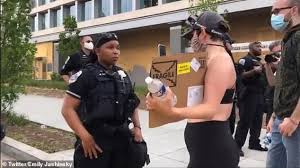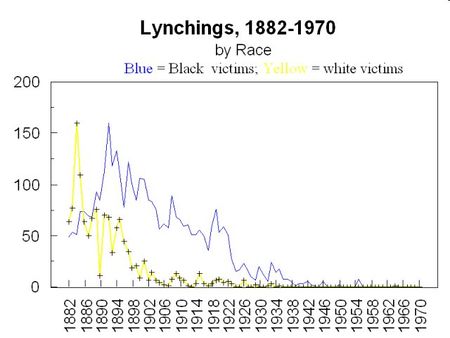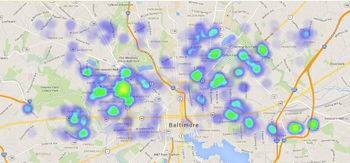Systemic racism
 From Conservapedia - Reading time: 11 min
From Conservapedia - Reading time: 11 min

Systemic racism is a phenomena that exists in many large American cities and police departments that have been controlled by Democrat mayors and city councils since passage of the Civil Rights Acts of 1964 and 1965. After passage of the Biden Amendment in 1975 repealing sections of the Civil Rights Act,[2] systemic racism flourished in Democrat strongholds.
In 2021, socialist leader Joe Biden issued a racist vaccine mandate which would disemploy anyone not receiving the covid vaccine.[3][4]
Origins[edit]

Source: Historical Statistics of the U.S., and is based on the 1952 Negro year Book.
- See also: Civil service system
While the Democratic party lost the Civil War, it won the battle to control the United States Civil Service bureaucracy.[5] Since the end of Reconstruction in 1876 and passage of the 1882 Pendleton Civil Service Reform Act, the Democratic party is no longer dependent on the spoils system and winning elections to maintain its power.
With the defeat of the Democrats and the South, to the victors went the spoils. Republicans immediately stripped white males who engaged in rebellion against the United States of the vote, and gave it to Blacks. Newly freed Blacks held local, state and federal elected and non-elected positions as Republicans. The white males who were deprived of the vote were also barred from holding any civil service position and were universally Democrats. This disenfranchisement created enormous resentment among Democrats, so they formed the Ku Klux Klan to engage in voter intimidation and suppression.
By 1876, the situation had become ungovernable for Republicans.[6] The Republicans had been able to pass the 13th, 14th, and 15th Amendments which guaranteed Blacks basic equality and civil rights, but eventually had to declare an amnesty for whites who engaged in rebellion. Reconstruction ended, and Republicans withdrew from social engineering which had divided the country so deeply and stirred up such bitterness and hatred among Democrats toward both Blacks and Republicans. Reconstruction earned Republicans the undying hatred of Democrats.[7][8]
African Americans in the South were left to the mercy of increasingly hostile state governments dominated by white Democratic legislatures; neither the legislatures, law enforcement or the courts worked to protect freedmen.[9] As Democrats regained power in the late 1870s, they struggled to suppress black voting through intimidation and fraud at the polls. Paramilitary groups such as the Red Shirts acted on behalf of the Democrats to suppress black voting. From 1890 to 1908, 10 of the 11 former Confederate states passed disfranchising constitutions or amendments,[10] with provisions for poll taxes,[11] residency requirements, literacy tests,[11] and grandfather clauses that effectively disfranchised most black voters and many poor white people. The disfranchisement also meant that black people could not serve on juries or hold any political office, which were restricted to voters; those who could not vote were excluded from the political system.
Cleveland was the leader of the Bourbon Democrats, the bourgeois wing of the party. They represented business elites, supported banking and railroad goals, promoted capitalism, opposed the annexation of Hawaii, fought for the gold standard, and opposed Bimetallism. They strongly supported ending Republican spoils with the Civil Service Reform Act and opposed corruption of city bosses, leading the fight against the Tweed Ring. The leading Bourbons included Samuel J. Tilden, David Bennett Hill and William C. Whitney of New York, Arthur Pue Gorman of Maryland, Thomas F. Bayard of Delaware, William L. Wilson of West Virginia, John Griffin Carlisle of Kentucky, William F. Vilas of Wisconsin, J. Sterling Morton of Nebraska, John M. Palmer of Illinois, Horace Boies of Iowa, L.Q.C. Lamar of Mississippi, and railroad builder James J. Hill of Minnesota. A prominent intellectual was pro-segregationist Woodrow Wilson. The Bourbons were in power when the Panic of 1893 hit; it was a deep depression and they took the blame. A fierce struggle inside the party ensued, with catastrophic losses for both the Bourbon and agrarian factions in 1894, leading to the showdown in 1896.
Jim Crow[edit]

- See also: Jim Crow
Jim Crow was the system of laws passed by Democrats promoting racial segregation in the Southern U.S. from the 1880s to 1964 in which African Americans were segregated (separated) in public schools and public places, so that they could not mingle in public with whites on equal terms. In addition to segregation, Jim Crow also assured that blacks had little or no political power.
During the Reconstruction period of 1863–77, Republicans provided civil rights protection in the South for freedmen—the African-Americans who had formerly been slaves. Reconstruction ended at different dates (the latest 1877), and was followed in each southern state by Redeemer governments that passed the Jim Crow laws to separate the races. In the Progressive Era, the restrictions were formalized, and segregation was extended to the federal government when the Democrats held the White House, 1913–21.
After 1877, the Redeemers reversed many of the civil rights gains that African Americans had made during Reconstruction, passing laws that mandated discrimination by both local governments and by private citizens. Since "Jim Crow law" is a blanket term for any of this type of legislation, the date of inception for the laws varies by state. The most important laws came in the 1890s with the adoption of legislation segregating railroad cars in New Orleans as the first genuine Jim Crow law. By 1915, under the Democrats, every southern state had effectively destroyed the gains in civil rights and liberties that blacks had enjoyed from the Reconstructionist efforts.
Many of the discriminatory Jim Crow laws were enacted to support racial segregation in everyday life. They required black and white people to use separate water fountains, public schools, public bath houses, restaurants, public libraries, buses and rail cars—even without legal segregation.
In the South, before the resort to widespread legal segregation around 1890, de facto segregation had replaced exclusion in Southern race relations. The integration stage was largely bypassed. Radical measures helped to institutionalize this shift to segregation. De jure or legal segregation took place when state laws required it, in the South and some border states. These laws mandated the physical separation of the races in order to create a social distance and minimize violence. The facilities purchased by taxpayers for black use was almost always inferior to those provided to whites. The most important laws required that public schools, public places and public transportation, like trains and buses, have separate facilities for whites and blacks. (These Jim Crow Laws were separate from the 1800-66 "Black Codes", which had defined an inferior legal status for free blacks.) State-sponsored school segregation was declared unconstitutional by the Supreme Court of the United States in 1954 in the seminal case of Brown v. Board of Education. All of the remaining Jim Crow laws were overruled by the Civil Rights Act of 1964 and the Voting Rights Act of 1965.
Between 1890 and 1920, many state governments under Democrat control prevented most blacks from voting by various techniques, such as poll taxes (a person had to pay a voluntary tax to vote) and fake literacy tests (that whites always passed but blacks always failed).[13] Of 181,000 African-American males of voting age in Alabama in 1900, only 3,000 were registered to vote. Typically, the ministers and ten to fifty prominent blacks in every county were allowed to vote.
Segregation[edit]

- See also: Plessy v. Ferguson
Melville Fuller was appointed Chief Justice by Democrt President Grover Cleveland in 1888. Fuller managed Democrat Stephen A. Douglas's campaign in the 1860 presidential election against Republican Abraham Lincoln. In 1896, a Fuller Court decision declared that racial segregation does not violate the Equal Protection Clause of the 14th Amendment so long as the "separate but equal" doctrine is followed. The decision allowed the continued existence of Jim Crow laws for another six decades.
Taking advantage of a deep split in the GOP, the Democrats took control of the House in 1910 and elected only the second Dem,ocrat since theior defea in the Civil War, the Northern segregationist Woodrow Wilson as president in 1912 and 1916. In his first year in office, Wilson permitted his Treasury and the Post Office to begin efforts to segregate the federal workforce, particularly in the Columbia District. It was often carried out surreptitiously. Yet Wilson condoned it and tried to duck its implications in a manner we would describe today as slimy. Wilson ordered Jim Crow segregation in all federal government facilities in Washington DC, wiping out 50 years of social progress that African-Americans made under Republicans. No longer could blacks and whites work together in government offices, eat in the same cafeterias, our use the same bathrooms. The Wilson administration went a step further. Through the Treasury Department's Office of the Architect, the bureau charged with construction and maintenance of federal buildings, federal buildings throughout the nation were ordered to furnish segregated bathrooms, even in Northern states were practices as such were virtually unknown.[16]
Wilson also curtailed minority appointments to executive, diplomatic, and judicial positions. Those latter numbers weren’t large — about 30 — but they were posts traditionally reserved for black Americans. The signal was terrible, even if it’s unclear that those black appointments would have met approval from a Senate controlled by Southern Democrats. Estimates reckon that between 15,000 and 20,000 black civil service employees, 6% of the federal workforce, were impacted by the administration’s actions.[17] Wilson successfully led Congress to a series of Progressive laws, including a reduced tariff, stronger antitrust laws, the Federal Reserve System, hours-and-pay benefits for railroad workers, and outlawing of child labor, raising wages for adults. Furthermore, constitutional amendments for prohibition and woman suffrage were passed in his second term. In effect, Wilson laid to rest the issues of tariffs, money and antitrust that had dominated politics for 40 years.
In 1972 Sen. Joseph Biden re-cycled the racist rhetoric of John C. Calhoun, arguing that school segregation was a "positive good" for Blacks. Calhoun famously laid out his doctrine of separation of the races as a civilizing force among Blacks which became Democrat talking points before the Dred Scott decision, throughout the Civil War, Reconstruction, the Jim Crow era, and the New Deal. In a Democrat filibuster on the floor of the Senate, Calhoun famously said:
| "I hold that in the present state of civilization, where two races of different origin, and distinguished by color, and other physical differences, as well as intellectual, are brought together, the relation now existing in the slaveholding States between the two, is, instead of an evil, a good—a positive good." |
Biden resurrected the idea that segregation was "for their own good" and that Blacks were grateful for it.
| “I think the concept of busing … that we are going to integrate people so that they all have the same access and they learn to grow up with one another and all the rest, is a rejection of the whole movement of black pride, a rejection of the entire black awareness concept, where black is beautiful, black culture should be studied; and the cultural awareness of the importance of their own identity, their own individuality.”[18] |
Urban America[edit]

- See also: Democrat plantation and Democrat urban issues
"Urban America" became a dogwhistle for Democrat-controlled cities with large African American populations after the 1965 Civil Rights Act. By 2020, seventeen of the twenty most violent cities in America had Democrat mayors, 2 had "Independent" mayors, and only 1 had a Republican.[21] In most cases, the most violent cities had not elected a Republican mayor or Republican controlled city council in 50, 60, and 70 years. The Democratic party became the norm, or system, in these urban enclaves.
To maintain the white supremacy of the dominant white Democrat majority, allocation of police resources were manipulated. Court rulings and affirmative action over the years forced changes in hiring and training to the extent where many departments had black police chiefs. The feminist hijacking of the civil rights movement even led to some departments having black and white women police chiefs.
Allocation of police resources took two forms - either making a priority of policing in statistically high crime areas or under-allocating police resources to those same areas, allowing criminal activity and criminal gangs to flourish, terrorizing innocent citizens. A strong police presence could lead to accusations of "tension" between police and communities, and weak presence would lead to accusations of "neglect".
See also[edit]
References[edit]
- ↑ https://pjmedia.com/news-and-politics/tyler-o-neil/2020/06/23/watch-white-blm-protester-calls-black-cop-n-word-in-profane-tirade-n567409
- ↑ https://www.politico.com/magazine/story/2015/08/joe-biden-integration-school-busing-120968_full.html
- ↑ https://www.newsweek.com/vaccine-mandates-will-have-disparate-impact-minorities-opinion-1619755
- ↑ https://hotair.com/jazz-shaw/2021/04/01/welcome-new-jim-crow-vaccine-passports-racist-n381478
- ↑ Trump vs the Deep State, Evan Osnos, The New Yorker, May 14, 2018
- ↑ "the Compromise of 1877, which resolved the disputed presidential election of 1876 by awarding the presidency to Republican Rutherford B. Hayes (who had lost the popular vote) in exchange for the removal of federal troops from the South after the Civil War (which benefited Democrats, who wished to end Reconstruction and return white supremacy to southern state governments)." Gilded Age politics: patronage. khanacademy.org
- ↑ See for example James O'Keefe debate with Hairy Hillbilly Hippie for an example of a partisan Democrat who votes against his own economic interests.
- ↑ See excerpt from Dinesh D'Souza's, Hillary's America: The Secret History of the Democratic Party, Regnery Publishing, July 18, 2016.
- ↑ Finkelman, Paul (2006). Encyclopedia of American Civil Liberties.
- ↑ Chafetz, Joshua Aaron (2007). Democracy's Privileged Few.
- ↑ 11.0 11.1 Klarman, Michael J. (2004). From Jim Crow to Civil Rights.
- ↑ https://history.house.gov/People/Listing/D/DE-PRIEST,-Oscar-Stanton-(D000263)/
- ↑ Whites who would be limited by the voting laws were protected by "grandfather clauses"--they could vote if their grandfather could vote. These clauses were found to be unconstitutional by the Supreme Court in 1915.
- ↑ https://www.politico.com/magazine/story/2015/08/joe-biden-integration-school-busing-120968_full.html
- ↑ https://researchblog.duke.edu/2021/04/08/black-americans-vaccine-hesitancy-is-grounded-by-more-than-mistrust/
- ↑ American Nightmare: The History of Jim Crow, Jerrold M. Packard, St. Martin's Press, 2003, pp. 124-125
- ↑ https://www.nysun.com/national/princetons-purge-of-wilson-follows-a-change/91174/
- ↑ https://www.washingtonexaminer.com/read-the-transcript-of-the-october-1975-npr-interview-with-sens-joe-biden-and-edward-brooke
- ↑ https://www.cheatsheet.com/culture/15-most-corrupt-cities-in-america-for-2018.html/
- ↑ https://www.baltimoresun.com/opinion/readers-respond/bs-ed-rr-confederate-baltimore-20170822-story.html
- ↑ https://www.breitbart.com/the-media/2020/06/29/washington-post-only-17-of-20-most-violent-cities-are-run-by-democrats-so-trump-is-wrong/
| |||||||||||||||||
 KSF
KSF